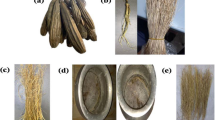Abstract
Vulcanization, by creating a three-dimensional cross-linked network, improves the physicalmechanical and thermal properties of elastomers. A popular agent for curing natural rubber (NR) is sulfur. Insoluble sulfur (IS) and rhombic sulfur (RS) are common allotropes of elemental sulfur. In this research, it was observed that the use of the two types of sulfur (IS and RS) gives different results. In terms of cure behavior, tear resistance and hardness, RS-vulcanized NR performed better, whereas in viscosity, tensile strength, aging and compression set, IS-vulcanized NR was better; because of the lack of blooming, IS could replace of rhombic sulfur as the curing agent in certain applications.
Similar content being viewed by others
References
J. S. Dick., Basic Rubber Testing: Selecting Methods for a Rubber Test Programme (ASTM International Publishing, USA, 2003).
P. Phinyocheep, Chemistry, Manufacture and Applications of Natural Rubber (Elsevier, New York, 2014).
M. P. Groover, Fundamentals of Modern Manufacturing: Materials Processes, and Systems (John Wiley & Sons, US, 2002).
M. Bolgar, J. Hubball, J. Groeger, and S. Meronek, Handbook for the Chemical Analysis of Plastic and Polymer Additives (CRC Press Inc. Publishing, USA, 2008).
C. Hall, Polymer Materials (2nd Ed., Macmillan Education Publishing, London, 1989).
R. Mukhopadhyay, S. Gupta, K. C. Baranwal, and A. K. Bhowmick, Reverse Engineering of Rubber Products: Concepts, Tools, and Techniques (CRC Press Inc. Publishing, USA, 2013).
B. G. Crowthe, Handbook of Rubber Bonding (Rapra Technology Ltd., England, 2001).
P. Coppens, Y. W. Yang, R. H. Blessing, W. F. Cooper, and F. K. Larsen, J. Am. Chem. Soc. 99 (3), 760 (1977).
R. Steudel, Elemental Sulfur and Sulfur-Rich Compounds I (Springer Heidelberg Publishing, New York, 1965).
L. C. Hollaway, M. K. Chryssanthopoulos, S. S. J. Moy, Advanced Polymer Composites for Structural Applications in Construction (Woodhead Publishing Ltd., England, 2004).
Author information
Authors and Affiliations
Corresponding author
Additional information
The article is published in the original.
Rights and permissions
About this article
Cite this article
Motavalizadehkakhky, A., Shahrampour, H. Determination of the most efficient form of sulfur for use as a natural rubber curing agent by comparison of physical and thermal attributes of cured rubber. Pet. Chem. 58, 89–93 (2018). https://doi.org/10.1134/S0965544118010048
Received:
Published:
Issue Date:
DOI: https://doi.org/10.1134/S0965544118010048




